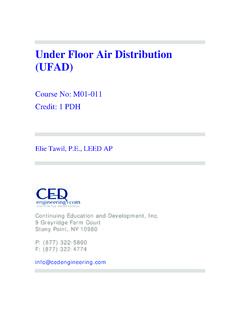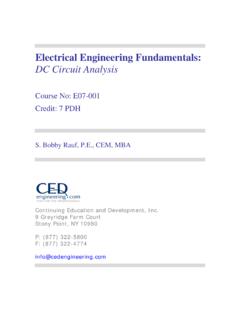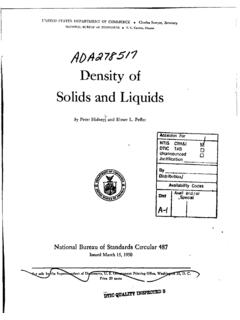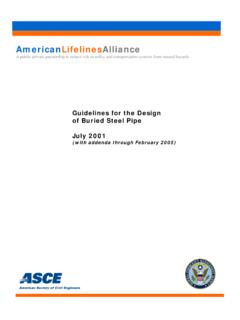Transcription of Course No: M05-022 Credit: 5 PDH - CED Engineering
1 Stairwell Pressurization Systems Course No: M05-022 . Credit: 5 PDH. A. Bhatia Continuing Education and Development, Inc. 9 Greyridge Farm Court Stony Point, NY 10980. P: (877) 322-5800. F: (877) 322-4774. Stairwell Pressurization Systems STAIRWELL PRESSURIZATION SYSTEMS. Introduction In a high-rise building, the stairs typically represent the sole means of egress during a fire. It is imperative for the exit stairs to be free of smoke and to incorporate design features that improve the speed of occupant egress. Most building codes require the fire stairwells in a high-rise building to be pressurized to keep smoke out. The stairwell pressurization serves several purposes: Inhibit migration of smoke to stairwells, areas of refuge, elevator shafts, or similar areas.
2 Maintain a tenable environment in areas of refuge and means of egress during the time required for evacuation. Facilitate the fire and rescue operation by improving visibility in the building for the firefighting crew. Protect life and reduce damage to property. The International Building Code (IBC) enforced much throughout the United States, recognizes three specific means for providing smoke proof enclosures: 1. Naturally ventilated stair balconies 2. Mechanical ventilation of a stair 1 66. Stairwell Pressurization Systems 3. Stair pressurization Due to the relative cost of the associated mechanical systems, and architectural space issues related to providing exterior balconies and stair vestibules, the stair pressurization system is the most widely selected design option.
3 This Course discusses the smoke control systems and examines the design considerations associated with stairwell pressurization systems. 2. Stairwell Pressurization Systems Table of Contents CHAPTER -1 .. 7. 1. REVIEW OF SMOKE .. 7. Hazards of Smoke .. 7. Smoke Management .. 7. Limit the fire .. 7. Compartmentation .. 7. Exhaust ventilation .. 7. Dilution .. 8. 8. Pressurization 8. Smoke Control .. 9. CHAPTER - 2 .. 10. 2. SMOKE 10. Stack Effect .. 11. Natural Convection .. 12. Thermal Expansion .. 13. Wind forces .. 14. Buoyancy of Combustible Gas .. 15. HVAC Systems .. 16. CHAPTER - 3 .. 18. 3. SMOKE CONTROL METHODS .. 18. Pressurization Method (IBC Section ) .. 19. Minimum and Maximum Pressure Requirements per NFPA 92A 20. Maximum Pressure Value.
4 21. Door Force Calculations .. 21. Airflow Velocity Method (IBC Section ).. 23. Exhaust Method (IBC Section ) .. 24. Performance Issues and Challenges .. 25. CHAPTER - 4 .. 27. 4. SYSTEM DESIGN .. 27. Codes and Standards .. 27. Pressurization Techniques .. 27. 3. Stairwell Pressurization Systems Non-compensated systems .. 28. Compensated systems .. 28. Single Injection Pressurization .. 28. Multiple Injection Pressurization .. 29. System Design and 30. Supply Air Fans .. 31. Fan Drive Package .. 32. Location of Fans .. 33. Distribution arrangements .. 34. Ductwork .. 35. Motorized Smoke & Fire Dampers (MSFD) .. 35. Pressure Relief Venting .. 35. Automatic Opening Door .. 36. Barometric Dampers .. 36. Motor-Operated 36. Exhaust Fan .. 36. Supply Fan Bypass.
5 37. Variable Frequency Drive for the Fan .. 37. CHAPTER - 5 .. 38. 5. DESIGN CALCULATIONS .. 38. Design Criteria .. 38. Design Methodology .. 38. Air Leakage Method (ASHRAE) .. 39. Leakage through Building Construction .. 40. Leakage through Door 41. Leakage through Open Doors .. 42. Total Airflow Requirements .. 43. Example .. 44. CHAPTER - 6 .. 49. 6. DESIGN REQUIREMENTS .. 49. IBC Design 49. Means of Egress .. 50. Mechanical .. 50. 4. Stairwell Pressurization Systems Electrical & Controls .. 51. CHAPTER - 7 .. 54. 7. CONTROL SYSTEM .. 54. Stairwell smoke control detection and 54. Operational schedules for pressurization systems .. 55. Plant off except in an emergency .. 55. Plant running continuously .. 55. Plant running continuously at reduced capacity except in an emergency 55.
6 Smoke Control System Equipment .. 56. Fire alarm control panel (FACP) .. 56. Firefighter's smoke control station (FSCS) .. 56. Response Time .. 58. Power systems .. 58. Power sources and power surges .. 58. Detection and control systems .. 59. Verification of operation equipment .. 59. Wiring .. 59. Emergency lighting .. 59. CHAPTER - 8 .. 60. 8. STAIRWELL PRESSURIZATION ACCEPTANCE TESTING .. 60. General conditions of 60. Pre-functional checklist .. 60. Sequence of operation .. 61. Activation of the system .. 62. Pressure differential .. 62. Air 62. Door opening force .. 63. Alarm system test .. 63. Qualifications .. 63. Reports .. 63. Documentation .. 64. Detailed Design Report .. 64. 5. Stairwell Pressurization Systems Operations and Maintenance Manual.
7 65. Summary .. 66. References .. 66. 6. Stairwell Pressurization Systems CHAPTER -1. 1. REVIEW OF SMOKE. Hazards of Smoke Smoke contains toxic and irritant gases. of all fire deaths are caused by smoke inhalation. Approximately 57% of fire deaths occur outside the room of fire origin. 47% of fire survivors could not see more than 12'. Smoke travels 120 to 240 Smoke Management A smoke management system includes all methods described below singly or in combination to modify or influence the smoke movement. Limit the fire An important consideration when designing a smoke control system is to ensure that evacuation is faster than the spread of smoke/fire. Controlling fire size, typically by means of hosepipes, hydrants and sprinklers should be a part of the overall smoke management program.
8 An automatic fire suppression system would be expected to limit the heat release rate and control the spread of fire. Compartmentation Compartmentation involves use of barriers with sufficient fire endurance to prevent spread of smoke to spaces remote from the fire. The method employs walls, partitions, floors, doors, smoke barriers, smoke dampers, and other fixed and mechanical barriers. The effectiveness of compartmentation is limited by the extent to which the free leakage paths are controlled through the barriers. Smoke control system designers often use the compartmentation method in combination with the pressurization method. Exhaust ventilation Smoke control in large open areas with high ceilings such as atria, shopping malls, concourse, airports, etc.
9 Is best achieved by exhaust ventilation. Hot smoke is 7. Stairwell Pressurization Systems collected at the high level in a space, where it is vented outside by means of a powered smoke exhausting fan. Make-up supply air below the smoke layer is also crucial, and is provided from the adjacent spaces free of smoke. Dilution The dilution method clears smoke from spaces remote from a fire. The method supplies outside air through the HVAC system to dilute smoke. Using this method helps to maintain acceptable gas and particulate concentrations in compartments subject to smoke infiltration from adjacent compartments. In addition, the fire emergency service can employ the dilution method to remove smoke after extinguishing a fire. Smoke dilution is also called smoke purging, smoke removal, or smoke extraction.
10 The approach may be used, for example, to clear smoke that has infiltrated a protected space such as an escape corridor or refuge lobby. Also dilution can be beneficial to the fire service for removing smoke after a fire has been extinguished. Airflow The airflow method controls smoke in spaces that have barriers with one or more large openings. It is used to manage smoke through open doorways, subway, railroad, and highway tunnels. The method employs air velocity across or between barriers to control smoke movement. A disadvantage of the airflow method is that it supplies increased oxygen to a fire. Within buildings, the airflow method must be used with great caution. The airflow method is best applied after fire suppression or in buildings with restricted fuel.















